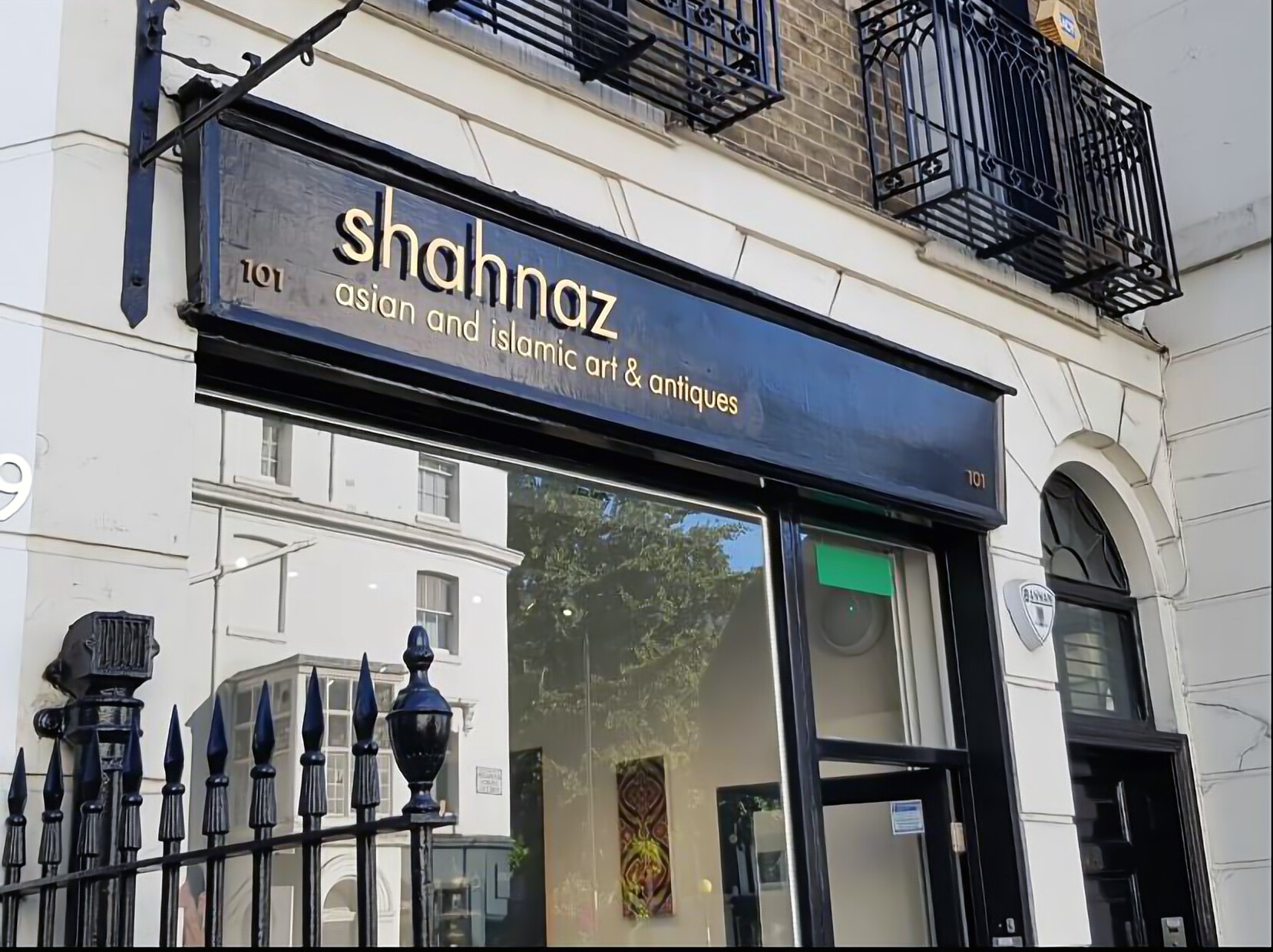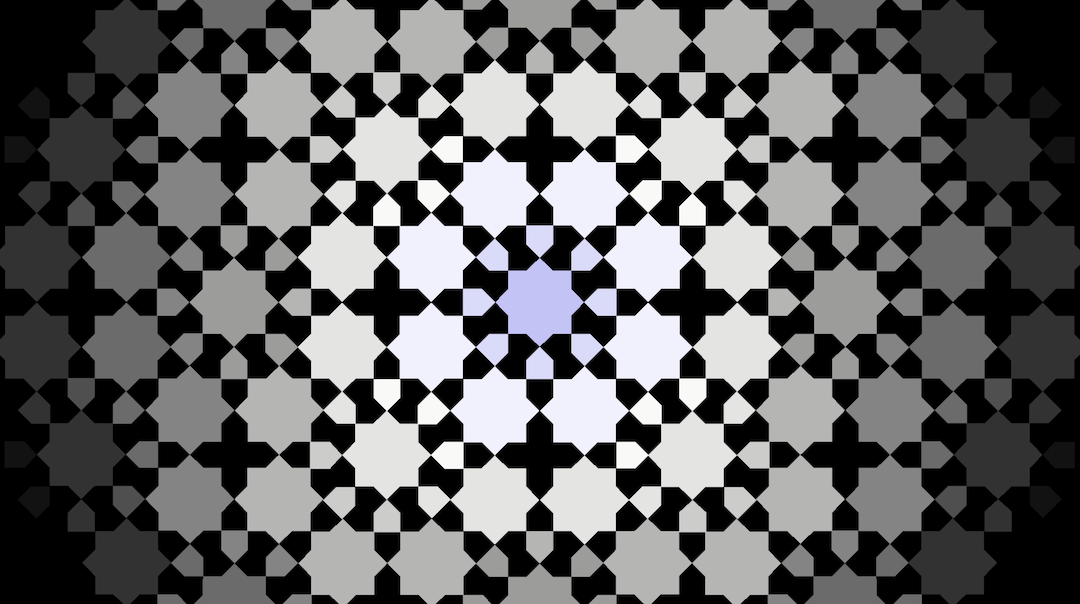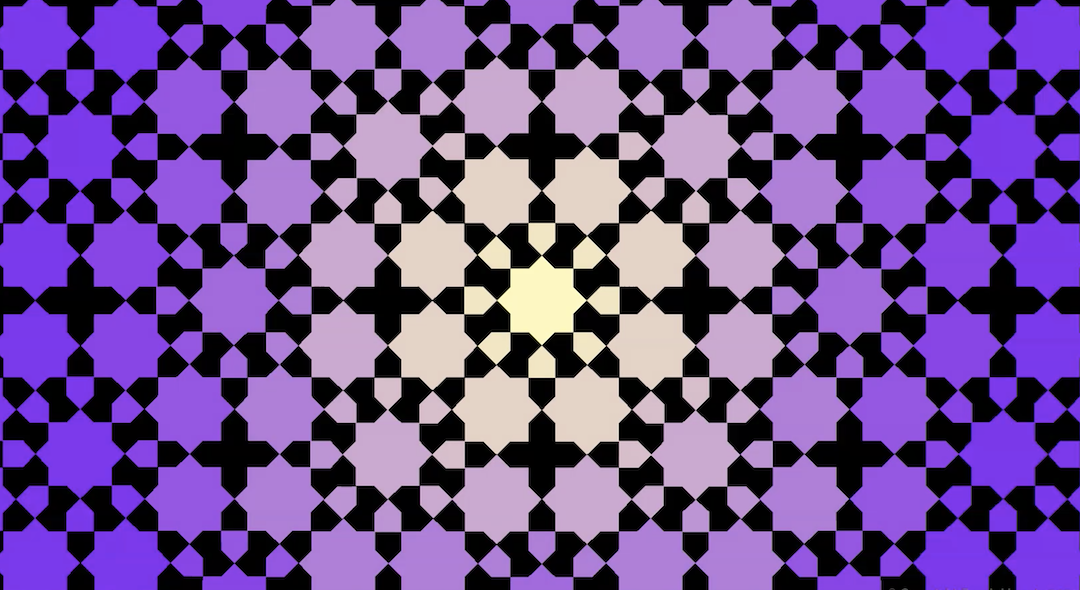
MIYAYO KATO

Visual Conversation: Aath and Antiques
Zarah Hussain’s Aath – which means ‘eight’ in Urdu – is a 3’25” minute generative digital animation composed of large star octagons and smaller pentagons, with moving colours between blue, green, pink, yellow, and red. At first, one star octagon appears in the centre from the complete darkness and gradually its number multiplies outwards connecting with each other. As they flow towards the edges, the colours move serenely from the centre to the surrounding. Keeping a symmetrical formation, the gradation of colours continues to transform, and soon it goes back to the darkness again as if the memory has been fading. Our focus explores the sequences, from detail to overview, multiplicity to unity. There is the external impetus of the whole, yet the mind is absorbed into the central octagon which keeps generating colours. In this continuum of visual reception, the work is enormously meditative.
Islamic ornamentation such as textile and fabric were always near to Hussain’s everyday life in her youth. Fascinated by mathematical purity and truth, she has engaged with geometry in her work in a quest to reinterpret the patterns intrinsic to Islamic arts. To create digital work, she used programming (C#) to make the colours and the timings of the animation as laid out in her design. What is exciting is that hand drawing always precedes every work.
Using a protractor, compass, and ruler, she elaborately visualises mathematical connectivity, carefully piecing together the lines and forms. To draw geometric patterns, one may start to find the central point from which to draw and connect the lines outwardly. Based on the immersive process of drawing, she plays this form exposing the outward movement of colours which indicates the endless expansion of geometry.
Geometry is the study of spatial order, which explores the relationship of forms, and its alignment bears witness to the way people have historically tried to understand universality in a holistic way. With grace and precision, the overwhelming repeatability connotes infinite possibilities of the universe. Hussain transforms her creative imagination of geometry into digital animation here, allowing the complex formula to visibly expand and evolve through colour and movement. Layering with a gradual change of colours gives her animation contemporary resonance. Moreover, despite the simple formation, shifting circles of colours have become a specific thread to draw together the interrelationship of people and ideas in Asian history.
In the Shahnaz Gallery, you can see the immensely exciting repertoire of geometric motifs and patterns decorating the surface of the antiques and this is amplified by Hussain, enacting a dialogue across time and regions. For this project, she drew inspiration from the design of the tomb of I’timād-ud-Daulah in Agra, India and Moroccan tiles, both of which are decorated with eight-pointed stars. In the space around Hussain’s Aath, you can appreciate a diverse cross-section of Asian antiques, including the cabinet on stand from Mughal in the late 17th to 18th century and the moulded Timurid star-shaped tile in the 15th century. Meanwhile, the Shahnaz Gallery also brings together other Asian cultural heritages, such as Gandharan sculpture from the 3rd to 4th century. It is inspiring to witness unexpected juxtaposition and contrast in the gallery. Hussain’s geometric images resonate not only with specific designs of the octagon but also with the essence embedded in the Asian antiques, with regard to how people perceived the world. Aath corresponds to the essential rhythm of the universe manifested in nature, which is the source of harmony, balance, and beauty. And there is a timeless language as well between the historical objects and the contemporary animation bridging the inside space with the external world on the street.
The artistic exchange between Asian countries has a long and intertwined history. Over the centuries, the study of geometry, built on practices and knowledge from ancient civilisations, has been the extraordinary form of pictorial expression, nurturing the human spirit. Aath traces what people created in Asian history and recalls its philosophy to grasp the image of cosmos. Representation of Islamic geometry in contemporary art offers the moment of reflection within us, evoking the rediscovery of the leitmotif of the Islamic art’s visual cannon.
Open to the passer-by on the street, Zarah Hussain’s generative animation is accessible to all generations. Whether or not they know the deeper meaning of the intricate design schema, the contemplative sequence with moving colours is captivating. As a form of vibrant, visual communication, Aath can be experienced as a springboard to explore the link between our classical heritage and the contemporaneity of the world we live in. It becomes a visual conversation through the physical and digital manifestation of dynamic spatial order.
Read more about Miyayo Kato here.

ON SHOW AT:
Shahnaz Gallery specialises in Islamic and Asian art and antiques, internationally renowned for rare and important works of art.





